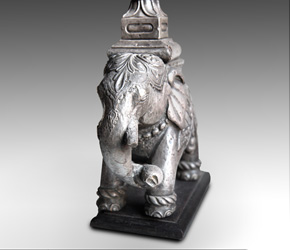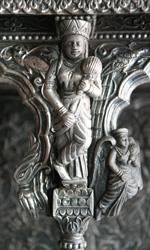Ghar Mandir Shrine or Home Altar
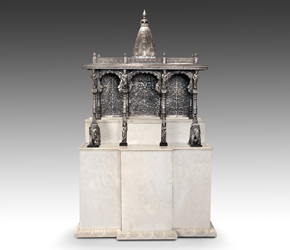 |
|
of rare Indian art |
"The outer edges of this Ghar Mandir are supported by two large elephants; atop is a Rekha-deula, or central pyramidal dome strongly resembling the dome of Kashi Vishwanath, the revered Golden Temple in the city of Varanasi, Uttar Pradesh, India"
Hindu devotional practice is not limited to public festivals and religious ceremonies. Many devotional traditions are carried out in the home, often conducted in special, sacrosanct rooms called puja rooms. In modern homes of Hindus and non-Hindus alike these rooms are often called meditation rooms. Regardless of what it is called, it is common to have an altar or shrine as part of the room. In India, these types of shrines are called ghar mandir. Ghar is a Gujarati word for house; and mandir means temple. The presence of the ghar mandir in any type of room is meant to facilitate a devotional atmosphere. There are many types of ghar mandir. Usually they are made of wood. Rarely, they are made of precious materials like this example, which consists of a Makrana marble base surmounted by a pavilion of deeply carved teak wood clad with chased and burnished silver. The top originated in Gujarat state, India; the bottom was built by PRIMTIVE.
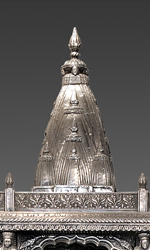 |
|
Typically, the ghar mandir is positioned in a prominent place in full frontal view to facilitate darshan or the feeling of divine presence. The appearance and iconography of the shrine helps to celebrate spiritual values as well as centering the family (and guests) in a devotional attitude of both humility and celebration. In the case of this piece, the mandapa or outer pavilion made in silver is upheld by eight columns that create three main porticos, each delineated by a scalloped arch form. At both the base and tops of the columns are devas or divine beings. The outer edges of the portico are supported by two large elephants; and atop the roof structure is a Rekha-deula, or central pyramidal dome strongly resembling the dome of Kashi Vishwanath, the revered Golden Temple in the city of Varanasi, Uttar Pradesh, India.
The appearance of the Devas can be interpreted as indicating the ascension of humankind to a divine position. The elephants, as purely Asian symbols represent royalty, power, wisdom, fertility and longevity. Ancient belief systems of Asia tend to twist and bend upon one another within the many varieties of Hinduism and Buddhism. In both traditions, man and elephant make their first appearance in the cosmos together, and the elephant is associated with water and rainfall, the primordial givers of life. Nevertheless, the predominant use of the elephant in eastern religious art is the representation of Ganesh, the great Hindu god of foresight, wisdom and the remover of obstacles. The appearance of the elephants on the bottom of the altar may thus also be interpreted as removing obstacles from man’s ascension to divinity.
Chased onto the back of the altar in silver and accompanying the Devas on top are winged angels called Apsaras. As spiritual beings they can be considered heavenly nymphs who can aid and inspire aspirants on their spiritual journey. Over their shoulders in the central panel are depictions of the sun and moon, which can be interpreted as indicating the basic unity of all relative natures; and in their hands they hold two attributes: vases containing the elixir of life, and a string of jewels symbolizing all never ending cycles. Also chased onto the back of the altar are peacocks. The peacock, which is the national bird of India, is a symbol of beauty, prosperity, love, compassion, benevolence, kindness, and compassion. In Hinduism, the bird is associated with Lakshmi, the deity representing wealth and prosperity. Their appearance, sitting near the top of a tree of life, can be interpreted as symbolizing humankind’s ability to grow “richer” as their spiritual dimension unfolds. As an aside, the peacock is also associated with Quan Yin in Asian spirituality. Quan Yin is revered throughout Asia as the embodiment of love, compassion, good will, and kindheartedness.
Finally, the dome of this ghar mandir as already noted resembles arguably the most famous of all Hindu temples called Kashi Vishwanath, located on the banks of the river Ganges in Varanasi, one of the oldest surviving cities in the world and considered the cultural capital of India. This temple is considered a living embodiment of all aspirants’ highest spiritual values. The temple is widely recognized as one of the most important places of worship in India, and due to its immense popularity, importance, and holiness, hundreds of temples have been built in the same architectural style. This particular ghar mandir is fashioned like these. It stands as testimony to the idea that humankind can seek, grow and unfold as compassionate, loving, adept, and fully realized spiritual beings.
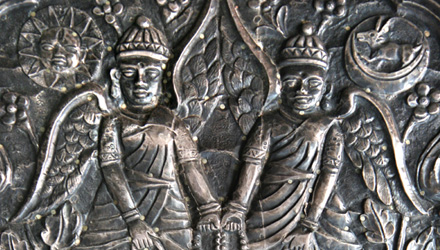
|
|
| |
|
Download this Article: Gar Mandir Shrine or Home Temple.pdf
